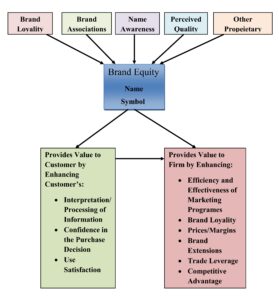Brand equity concept
Definition
The value of a brand. From a consumer perspective, brand equity is based on consumer attitudes about positive brand attributes and favorable consequences of brand use.”
— American Marketing Association
“A set of assets and liabilities linked to a brand, its name and symbol, that adds to or subtracts from the value provided by a product or service to a firm and/or to that firm’s customers.”
— David Aaker
“The tangible and intangible value that a brand provides positively or negatively to an organization, its products, its services, and its bottom-line derived from consumer knowledge, perceptions, and experiences with the brand.”
— Susan Gunelius
.
Brand equity is set of brand assets and liabilities linked to a brand,its name and symbol,that add or subtract from the value provided by a product or service to a firm and /or to that firm’s customers.For assets or liabilities to underlie brand equity they must be linked to the name and /or symbol of the brand.If the brands’s name or symbol should change,some or all of the assets or liabilities could be affected and even lost,although some might be shifted to a new name and symbol.The assets and liabilities on which brand equity is based will differ from context to context.However,they can be usually grouped into five categories:
- Band loyalty
- Name awareness
- Perceived quality
- Brand associations in addition to perceived quality
- Other proprietary brand assets-patents,trademarks,channel,relationships,etc.
The concept of brand equity is summarized in below figure:
The five categories of assets that underlie brand equity are shown as being the basis of brand equity.
The figure also shows that brand equity creates value for both the customer and the firm.
Providing Value to the customer
Brand equity assets generally add or subtract value for customers.They can help them interpret,process and store huge quantities of information about products and brands.They also can affect customers confidence in the purchase decision(due to either past use experience or familiarity with brand and its characteristics).Potentially more important is the fact that both perceived quality and brand associations can enhance customer’s satisfaction with the use experience.
Providing Value to the firm
As part of its role in adding value for the customer,brand equity has the potential to add value for the firm by generating marginal cash flow in at least half dozen ways.
First,it can enhance programs to attract new customers or recapture old ones.A promotion for example,which provides an incentive to try a new flavour or new use will be more effective if the brand is familiar and if there is need to combat a consumer skeptical of brand equity.
Second,the last four brand equity dimensions can enhance brand loyalty. The perceived quality,the associations,and all well known name can provide reasons to buy and can affect use satisfaction,reducing the incentive to try other.Enhanced brand loyalty is especially important in buying time to respond when competitors innovate and obtain product advantages.
Third,brand equity will usually allow higher margins by permitting both premium pricing and reduced reliance upon promotions.In many context the elements of brand equity serve to support premium pricing.Further,a brand with a disadvantage in brand equity will have to invest more in promotional activity,sometimes just to maintain its position in the distribution channel.
Fourth,brand equity can provide a platform for growth via brand extensions,Ivory as we have seen,has been extended into several cleaning products,creating creating business areas that would have been much more expensive to enter without the Ivory name.
Fifth,Brand equity can provide leverage in the distribution channel.Like customers,the trade has less uncertainty dealing with a proven brand name that has already achieved recognition and associations. A strong brand will have an edge in gaining both shelf facings and cooperation in implementing marketing programs.
Finally,brand equity assets provide a competitive advantage that often presents a real barrier to competitors.An association e.g Tide is detergent for tough family laundry jobs,may preempt an attribute that is important for a given segment.For example another brand would find it difficulty to compete with Tide for the “tough cleaning job” segment.


